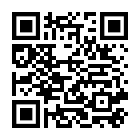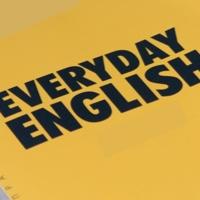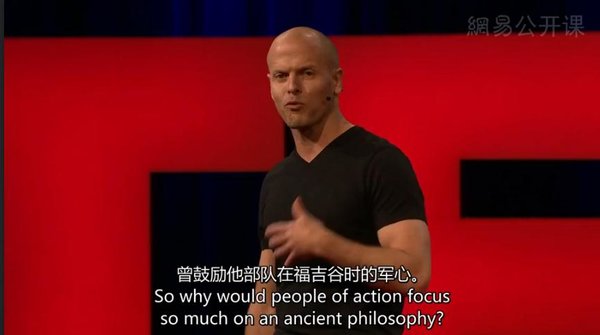TED-027—— 你该认清你的恐惧而不是目标
视频地址:
http://open.163.com/movie/2017/8/G/1/MCQSHUBAS_MCQV5AKG1.html
感悟:这篇演讲直入人心,主要是讲我们如何面对恐惧和挫折。
作者用的一个人生活状态的比喻给我留下了深刻印象:一头站在雨中的牛,它不悲伤,它也并非快乐,它不过是一个逆来顺受的无动于衷的生物。
我们在遇到挫折的时候,作者提出,我们不是要反复强调你的目标,你最后要做成什么样子,而制定自己的恐惧清单:(三页纸)
1.将要发生的最糟糕的事情,写10到20个,然后写上如何预防和修复措施
2.尝试去做会带来哪些好处,部分成功会带来哪些好处?
3.不行动的代价是什么,6个月,12个月,3年后我会是什么样子?
永远记住两句话:1.折磨我的往往是想象而不是真实。
2.简单选择,痛苦生活,痛苦选择,简单生活。
1.So I became very methodical about testing different ways that I could manage my ups and downs, which has proven to be a good investment. (Laughs) Many normal people might have, say, six to 10 major depressive episodes in their lives. I have bipolar depression. It runs in my family. I've had 50-plus at this point, and I've learned a lot.I've had a lot of at-bats, many rounds in the ring with darkness, taking good notes. So I thought rather than get up and give any type of recipe for success or highlight reel, I would share my recipe for avoiding self-destruction, and certainly self-paralysis.
因此我开始井然有序地尝试不同方式 来控制我生活的跌宕起伏, 现在看来这是个不错的投资。 (笑声) 大部分普通人一生中会有 6-10 次 较为严重的抑郁阶段。 我有躁郁症,是我家的遗传病。 我大概已经有 50 多次 我学到了很多。 我内心有很多蝙蝠, 它们在黑暗中轮回着飞行, 寻找着出口。 因此我认为与其给大家任何成功心灵鸡汤 或者经典语录, 我会分享如何避免自我毁灭的秘诀, 与避免自我麻痹的秘方。
2.a cow standing in the rain. It's not sad. It's not particularly happy. It's just an impassive creature taking whatever life sends its way.
一头站在雨中的牛。 它不悲伤,也并非快乐。 它不过是一个逆来顺受的 无动于衷的生物。
3.So around 300 BC in Athens, someone named Zeno of Citium taught many lectureswalking around a painted porch, a "stoa." That later became "stoicism." And in the Greco-Roman world, people used stoicism as a comprehensive system for doing many, many things. But for our purposes, chief among them was training yourself to separate what you can control from what you cannot control, and then doing exercises to focus exclusively on the former. This decreases emotional reactivity, which can be a superpower.
在公元前300年左右的雅典, 一位叫“季蒂昂的芝诺”的导师 教授很多课程 经常游走在涂满绘画的门廊,即“拱柱”。 这之后就成为“斯多葛学派”。 而在希腊罗马世界, 人们把斯多葛学派作为一个全面的系统 能解决很多事情。 于我们而言, 最主要的目的是训练我们自己 将可控和不可控的事情分开, 然后训练如何专注于于前者。 这将降低情绪的反应力, 这将成为一种超能力。
4.And I did find a quote that made a big difference in my life, which was, "We suffer more often in imagination than in reality," by Seneca the Younger, who was a famous Stoic writer. That took me to his letters, which took me to the exercise, "premeditatio malorum," which means the pre-meditation of evils. In simple terms, this is visualizing the worst-case scenarios, in detail, that you fear, preventing you from taking action, so that you can take action to overcome that paralysis. My problem was monkey mind -- super loud, very incessant. Just thinking my way through problems doesn't work. I needed to capture my thoughts on paper. So I created a written exercise that I called "fear-setting," like goal-setting, for myself. It consists of three pages. Super simple.
我的确找到一个改变我人生的警句, ““折磨我們的往往是想像, 而不是真實”” 出自塞内卡, 他是著名的斯多葛学派作家。 这引领我读他的书信, 让我开始练习,"premeditatio malorum," 意思是在最坏情况来临前提前预想。 简而言之, 预想最坏的情景及你所恐惧的细节, 防止你采取任何行动, 因此你可以采取行动,来摆脱恐惧。我当时头脑一片混乱, 充满着连续不断嘈杂的声音。 通过思考我的问题没有什么用处。我需要把想法都写在纸上。 因此我设计了一个写作练习 我称之为“恐惧设置”, 就像目标设置一样。 它由3页纸组成。 非常简单。
5.The first page is right here. "What if I ...?" This is whatever you fear, whatever is causing you anxiety, whatever you're putting off. It could be asking someone out,ending a relationship, asking for a promotion, quitting a job, starting a company. It could be anything.
第一页是这样的。 “如果我...?” 这是你所恐惧的东西, 让你焦虑的东西, 被拖延的东西。 它可能是邀约某人, 结束一段关系, 提出升职,辞职或者创业。 它可以是任何事情。
6.In the first column, "Define," you're writing down all of the worst things you can imagine happening if you take that step. You want 10 to 20.
在第一栏“定义”中, 你写下所有你预想中 会发生的最坏的事情 如果你采取这一步行动。你需要写下10到20个。
7.And then you go to the "Prevent" column. In that column, you write down the answer to: What could I do to prevent each of these bullets from happening, or, at the very least, decrease the likelihood even a little bit?
这时可以使用“预防”一栏。 在这一栏中,你写下答案: 我能做什么来预防这些事情发生, 或者至少降低发生的可能性?
8.Then we go to "Repair." So if the worst-case scenarios happen, what could you do to repair the damage even a little bit, or who could you ask for help?
接下来我们到“修复”一栏。 如果最坏的情况发生, 你能做什么来减轻损失, 或者你能向谁寻求帮助?
9.The second page is simple: What might be the benefits of an attempt or a partial success? You can see we're playing up the fears and really taking a conservative look at the upside. So if you attempted whatever you're considering, might you build confidence, develop skills, emotionally, financially, otherwise?
第二页很简单: 一次尝试或部分成功会带来哪些好处? 你可以看到我们直面恐惧 同时保持谨慎。 因此当你尝试你想做的事情的时候, 也许你可以建立自信, 提高情绪、经济等方面的技能。
10.Page three. This might be the most important, so don't skip it: "The Cost of Inaction."Humans are very good at considering what might go wrong if we try something new, say, ask for a raise. What we don't often consider is the atrocious cost of the status quo -- not changing anything. So you should ask yourself, if I avoid this action or decision and actions and decisions like it, what might my life look like in, say, six months, 12 months, three years? Any further out, it starts to seem intangible. And really get detailed -- again, emotionally, financially, physically, whatever.
第三页。 这很可能是最重要的,不要跳过。 “不行动的代价”。 人类非常善于设想可能出错的事情 如果我们尝试新的事情,例如加薪。 我们通常忽视维持现状所付出的代价 什么都不改变。 因此你要扪心自问, 如果我错过这次行动或决定 以及类似的行动和决定, 6个月,12个月,3年后我的 生活会是什么样子? 刚开始,这些变化非常细微。 但从情感、经济、身体等方面 再次仔细地思考。
11.Those are the three pages. That's it. That's fear-setting. And after this, I realized that on a scale of one to 10, one being minimal impact, 10 being maximal impact, if I took the trip, I was risking a one to three of temporary and reversible pain for an eight to 10 of positive, life-changing impact that could be a semi-permanent.
这就是恐惧设置的三页纸。 之后,我意识到用1到10来评测, 1是最小的影响,10是最大的影响, 如果我踏上旅途,我将面对 1到3个短暂的可解决的苦恼, 还有8到10个能深刻改变我生活的 积极影响。
12.And I can trace all of my biggest wins and all of my biggest disasters averted back to doing fear-setting at least once a quarter. It's not a panacea. You'll find that some of your fears are very well-founded.
回顾我取得赢得的最大成就 和避免的巨大灾难 都是因为至少每一季度 我都做一次恐惧设置。 它并非灵丹妙药。 你会发现有些恐惧貨真價實。
13.And he closed with two things. Number one: he couldn't imagine any life more beautiful than that of a Stoic. And the last was his mantra, which he applies to everything, and you can apply to everything:
"Easy choices, hard life. Hard choices, easy life."
The hard choices -- what we most fear doing, asking, saying -- these are very often exactly what we most need to do. And the biggest challenges and problems we facewill never be solved with comfortable conversations, whether it's in your own head or with other people.
So I encourage you to ask yourselves: Where in your lives right now might defining your fears be more important than defining your goals? Keeping in mind all the while, the words of Seneca: "We suffer more often in imagination than in reality."
他不仅熟知斯多葛学派, 他还指出,他所有重要的决定, 他的人生转折点, 当他捍卫自己的原则和遵循道德时, 他时如何用斯多葛学派以及 类似恐惧设定的方法, 这令我感到震惊。他总结了两点。 第一:他无法想象生活中会有比 拥有斯多葛学派更美好的生活。 最后一个是他可以应用于 任何事情的格言, 你也可以用于任何事物:“简单选择,痛苦生活。 痛苦选择,简单生活。“困难的选择, 我们最害怕去做的、问的、说的, 这些有可能正是我们最需要做的。 我们面对的最大挑战和困难是 永远不能通过一个轻松的谈话就能解决, 不管是你自我思考还是和别人探讨。因此我鼓励你问自己: 你现在处在你人生中的哪个阶段 也许会让你看清恐惧而不是目标? 请将塞內卡的话铭记在心: “折磨我們的往往是想像, 而不是真實”。

 她理财 App
她理财 App







没有TS姐姐的每次鼓励,估计真坚持不下去。
看见就是力量!感谢,感谢!给我坚持的勇气!